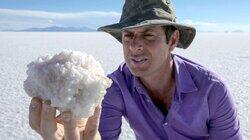The Americas

Professor Iain Stewart uncovers clues hidden within the New York skyline, the anatomy of American alligators and inside Bolivian silver mines, to reconstruct how North and South America were created. We call these two continents the New World, and in a geological sense they are indeed new worlds, torn from the heart of an ancient supercontinent - the Old World of Pangaea.
Iain starts in New York, where the layout of the city's iconic skyscrapers provide a link to a long-lost world. Deep within their foundations is evidence that 300 million years ago New York was at the heart of a huge mountain range - part of the vast supercontinent called Pangaea.
Trekking into the Grand Canyon, Iain uncovers a layer of sandstone from Pangaean times that shows there was a vast desert either side of the mountains. Footprints in the rocks of the Grand Canyon reveal that there was only one type of animal that could thrive here - a newly evolved group called the reptiles. Iain gets up close and personal with the closest living relative of those early reptiles - the alligator.
Two hundred million years ago, Pangea underwent a violent transformation. North and South America were carved from Pangaea, and pushed westwards as separate island continents. To see how this westward movement shaped South America's often bloody human history, Iain travels to Potosi in Bolivia. Cerro Rico is one of the most dangerous mines in human history. Iain goes to the heart of this extinct volcano to reveal the process that has shaped South America - subduction.
Subduction has also created the longest continual mountain range in the world - the Andes. At its heart lies the stunning ethereal landscape of the Salar de Uyuni, a vast salt flat where a lake has been uplifted thousands of metres above sea level. The lithium found here may be a new source of mineral wealth for Bolivia, for use in mobile phones.
The last chapter in the story of the Americas is told through that most typically Andean animal, the llama. But like much of South America's wildlife it originated in North America, and only came south when the two island continents of North and South America joined three million years ago.
Since that momentous joining the story of the Americas has been a shared one. Together they continue their westward drift away from the Old World. However, on a cultural and economic level you could argue that the opposite is the case. In our new global economy the Americas are at the very heart of our connected world.
Trailer
Recently Updated Shows

The Rookie
The Rookie is inspired by a true story. John Nolan is the oldest rookie in the LAPD. At an age where most are at the peak of their career, Nolan cast aside his comfortable, small town life and moved to L.A. to pursue his dream of being a cop. Now, surrounded by rookies twenty years his junior, Nolan must navigate the dangerous, humorous and unpredictable world of a "young" cop, determined to make his second shot at life count.

MobLand
With the most powerful clients in Europe, MobLand will see family fortunes and reputations at risk, odd alliances unfold, and betrayal around every corner; and while the family might be London's most elite fixers today, the nature of their business means there is no guarantee what's in store tomorrow.
MobLand follows two generations of gangsters, the businesses they run, the complex relationships they weave and the man they call upon to fix their problem.

Daredevil: Born Again
Matt Murdock finds himself on a collision course with Wilson Fisk when their past identities begin to emerge.

The Studio
As movies struggle to stay alive and relevant, Matt and his core team of infighting executives battle their own insecurities as they wrangle narcissistic artists and craven corporate overlords in the ever-elusive pursuit of making great films. With their power suits masking their never-ending sense of panic, every party, set visit, casting decision, marketing meeting, and award show presents them with an opportunity for glittering success or career-ending catastrophe. As someone who eats, sleeps, and breathes movies, it's the job Matt's been pursuing his whole life, and it may very well destroy him.
